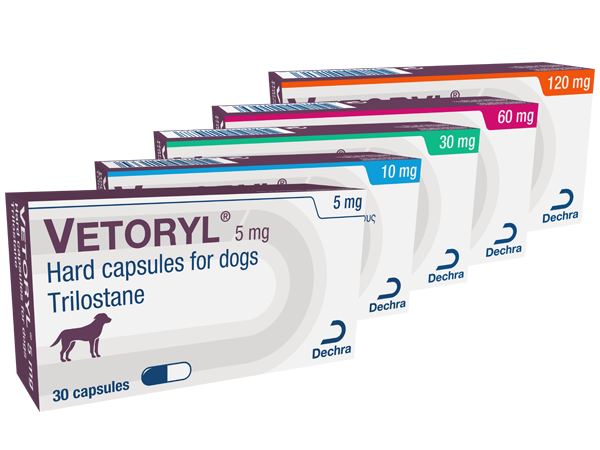Vetoryl®
Vetoryl® treats Cushing’s Syndrome which is the production of excessive amounts of cortisol, an important hormone that helps regulate the bodies metabolism. Left untreated Cushing’s Syndrome can have harmful effects on organs and on body regulation. It is one of the most common hormonal disorders, mostly occurring in middle-aged and older dogs.

What it does
Vetoryl® contains a medicine called Trilostane which reduces the production of cortisol by the adrenal glands. Usually, within the first two weeks of treatment the clinical signs of Cushing’s such as lethargy, increased drinking, eating and urination will improve. It takes a bit longer for the pot belly, hair loss and skin changes to correct - between 3-6 months.Description
Cushing’s syndrome is more often seen in older dogs, and in smaller breeds of dog. Because some of the signs of Cushing’s are very similar to those associated with normal ageing processes diagnosis can be challenging.The most noticeable signs of Cushing’s syndrome include:
- excessive urination with possible incontinence - increased water intake - ravenous appetite - pot-belly
- excessive panting, even at rest
- muscle wastage and weakness
- lethargy
- hairless, thin skin and recurrent skin infections - frequent urinary tract infections
How to Administer
Give Vetoryl® to your dog with breakfast in the morning for easy absorption. After ten days it will be time to return to the vet with your dog for monitoring. The vet will adjust the dose of Vetoryl® to meet your dog’s specific needs. Note: a vet visit every three months will then be required for regular monitoring.Side Effects
Although Vetoryl® is generally well-tolerated by most dogs side effects could include vomiting, diarrhoea and anorexia, and lethargy. If this happens stop treatment and return to the vet as soon as possible.Pack
Available in five strengths 5mg, 10mg, 30mg, 60mg and 120mg capsules.More Information
Dechra has worked with Peter Graham BVMS PhD CertVR DipECVCP MRCVS to develop an online app which will help confirm your suspicions of Cushing’s. To find out more visit www.diagnosingcushings.comDechra also has an owner dedicated website which helps owners understand the disease – www.canine-cushings.co.uk
Cushing's Connect is here to support you with everything from diagnosis to monitoring – www.dechra.co.uk/cushings-connect
Videos
Watch a series of short videos from Professor Stijn Niessen on the importance of looking at the clinical picture and measuring quality-of-life.
Vetoryl® is the only veterinary licensed product in New Zealand for the treatment of canine Cushing’s syndrome.



